Rising Healthcare Expenditure
In South America, healthcare expenditure has been on an upward trajectory, which significantly impacts the radiofrequency ablation-devices market. Governments and private sectors are increasingly investing in healthcare infrastructure, aiming to improve access to advanced medical technologies. According to recent data, healthcare spending in the region is projected to reach approximately $500 billion by 2026, reflecting a compound annual growth rate of around 5%. This increase in funding facilitates the procurement of sophisticated medical devices, including radiofrequency ablation systems. As hospitals and clinics upgrade their facilities to meet modern healthcare demands, the adoption of these devices is likely to rise. The radiofrequency ablation-devices market stands to benefit from this trend, as enhanced financial resources enable healthcare providers to offer cutting-edge treatments to their patients.
Supportive Regulatory Environment
A supportive regulatory environment in South America is fostering growth in the radiofrequency ablation-devices market. Regulatory bodies are increasingly recognizing the importance of advanced medical technologies and are streamlining approval processes for innovative devices. This proactive approach encourages manufacturers to invest in research and development, leading to the introduction of new and improved radiofrequency ablation systems. The regulatory landscape is evolving to ensure that patients have access to safe and effective treatment options. As a result, the radiofrequency ablation-devices market is likely to benefit from accelerated product launches and increased competition among manufacturers, ultimately enhancing the availability of cutting-edge solutions for healthcare providers.
Growing Awareness of Treatment Options
There is a notable increase in awareness regarding treatment options available for various medical conditions in South America, which serves as a catalyst for the radiofrequency ablation-devices market. Educational campaigns and outreach programs by healthcare organizations have contributed to a better understanding of minimally invasive procedures among patients and healthcare professionals alike. This heightened awareness is likely to lead to increased patient inquiries and demand for radiofrequency ablation as a viable treatment alternative. As patients become more informed about the benefits of such procedures, including shorter recovery times and reduced hospital stays, the radiofrequency ablation-devices market is expected to experience growth. The shift towards patient-centered care further emphasizes the importance of providing accessible information about innovative treatment modalities.
Increasing Prevalence of Chronic Diseases
The rising incidence of chronic diseases such as cancer, cardiovascular disorders, and obesity in South America is a primary driver for the radiofrequency ablation-devices market. As healthcare systems strive to manage these conditions effectively, the demand for innovative treatment options increases. For instance, the World Health Organization indicates that non-communicable diseases account for approximately 77% of all deaths in the region. This alarming statistic underscores the necessity for advanced medical interventions, including radiofrequency ablation, which offers minimally invasive solutions. The growing patient population requiring such treatments is likely to propel market growth, as healthcare providers seek to adopt technologies that enhance patient outcomes while reducing recovery times. Consequently, the radiofrequency ablation-devices market is poised for expansion as it addresses the urgent healthcare needs of the population.
Technological Innovations in Medical Devices
The radiofrequency ablation-devices market is significantly influenced by ongoing technological innovations in medical devices. In South America, advancements in device design, such as improved energy delivery systems and enhanced imaging techniques, are transforming the landscape of ablation procedures. These innovations not only increase the efficacy of treatments but also enhance safety profiles, making procedures more appealing to both patients and healthcare providers. For instance, the introduction of real-time imaging during ablation procedures allows for greater precision, potentially leading to better patient outcomes. As these technologies continue to evolve, the radiofrequency ablation-devices market is likely to expand, driven by the demand for state-of-the-art solutions that align with contemporary medical practices.


















Leave a Comment